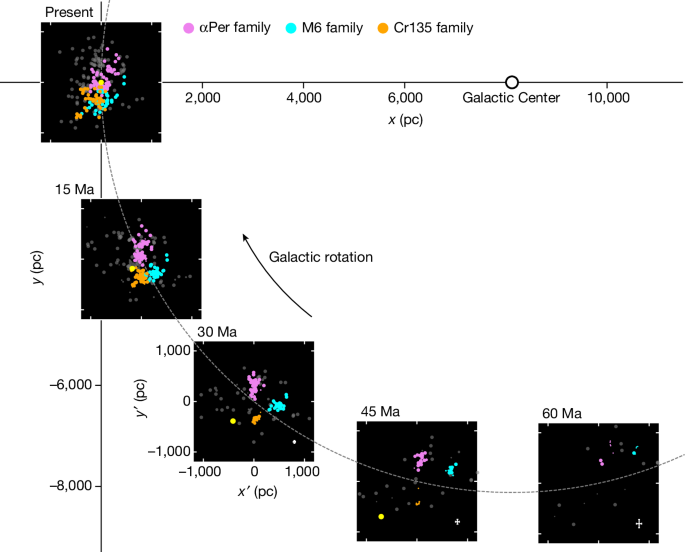Unveiling the Origins of Nearby Young Star Clusters: Tracing Their Formation in Three Massive Complexes
Core Concepts
The majority of nearby young star clusters within 1 kiloparsec of the Sun originated from three distinct, massive star-forming complexes more than 30 million years ago.
Abstract
The content discusses recent efforts to understand the structure of the local interstellar medium and the star formation history in the solar neighborhood. Using precise data from space astrometry missions and large-scale spectroscopic surveys, the authors have analyzed the spatial distribution and origins of 272 high-quality young star clusters within 1 kiloparsec of the Sun.
The key findings are:
57% (155 out of 272) of these young clusters arose from three distinct spatial volumes or massive star-forming complexes.
These three complexes, which include the well-known Taurus and Scorpius–Centaurus regions, were compact and massive, producing over 200 supernovae that shaped the local interstellar medium.
The supernovae from these clustered star formation events are believed to have created the Local Bubble and the nearby supershell GSH 238+00+09, both of which are visible in modern three-dimensional dust maps.
This study provides new insights into the recent star formation history and the interconnected origins of nearby young stellar groups.
Most nearby young star clusters formed in three massive complexes - Nature
Stats
57% of 272 high-quality young clusters within 1 kiloparsec of the Sun originated from three distinct spatial volumes or massive star-forming complexes.
More than 200 supernovae were produced from these three families of clusters.
Quotes
"Recent studies using precise data from space astrometry missions have revealed nearby, newly formed star clusters with connected origins."
"At present, dispersed throughout the solar neighbourhood, their past positions more than 30 million years ago reveal that these families of clusters each formed in one of three compact, massive star-forming complexes."
Key Insights Distilled From
by Came... at www.nature.com 06-10-2024
https://www.nature.com/articles/s41586-024-07496-9
Deeper Inquiries
What factors contributed to the formation of these three massive star-forming complexes, and how do they compare to other star-forming regions in the galaxy?
The formation of these three massive star-forming complexes can be attributed to several factors, including the presence of dense molecular clouds, triggering mechanisms such as supernova explosions or interactions with other stellar systems, and the overall gravitational instability of the interstellar medium. These complexes are characterized by their high concentration of young, massive stars, indicating intense ongoing star formation activity. In comparison to other star-forming regions in the galaxy, these complexes stand out due to their proximity to the Sun and the relatively recent formation of the star clusters within them. The interconnected nature of the young clusters within each complex suggests a shared origin and a common history of star formation events.
How might the supernovae from these clustered star formation events have influenced the subsequent evolution and dynamics of the local interstellar medium?
The supernovae resulting from the clustered star formation events within these complexes would have had a significant impact on the evolution and dynamics of the local interstellar medium. These supernovae release immense amounts of energy and matter into their surroundings, creating shockwaves that can trigger further star formation, disperse heavy elements crucial for planetary formation, and shape the structure of the interstellar medium. The combined effect of over 200 supernovae from these star-forming complexes would have contributed to the creation of features like the Local Bubble and supershell GSH 238+00+09, altering the distribution of gas and dust in the region and influencing the conditions for future star formation processes.
What insights can be gained from studying the detailed properties and compositions of the young stellar populations within these three complexes, and how might they inform our understanding of the star formation process?
Studying the detailed properties and compositions of the young stellar populations within these three star-forming complexes can provide valuable insights into the mechanisms and dynamics of star formation. By analyzing factors such as the age, mass distribution, metallicity, and spatial distribution of these young stars, researchers can better understand the conditions under which these stars formed, the role of feedback mechanisms in regulating star formation, and the overall evolution of stellar clusters within these complexes. These insights can inform our understanding of the star formation process on both local and galactic scales, shedding light on the factors that influence the formation and evolution of stars and planetary systems in diverse environments.
0
